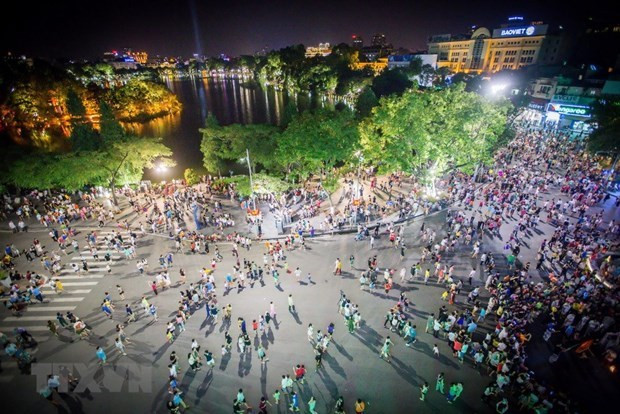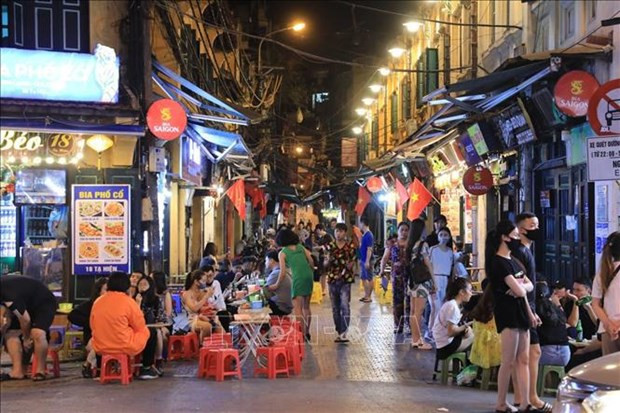
Walkers at Dong Kinh Nghia Thuc Square in Hanoi's Hoan Kiem district. (Photo: VNA)
The city’s major night-time hubs include streets in the Old Quarter such as Ta Hien, Luong Ngoc Quyen, Ma May, Hang Ngang, Hang Dao, Dong Xuan, Hang Bong and Hang Buom, where tourists often gather for shopping, and culinary and entertainment activities. The streets become busier at weekends.
The pedestrian streets around Hoan Kiem Lake are also attractive to visitors. In the first three years of launching, the number of international visitors choosing to stay in Hoan Kiem district rose 13-22.8 percent each year, contributing to raising State budget collection in the district.
This year, the city has opened two additional walking zones of Trinh Cong Son street and Son Tay ancient fortress.
According to Nguyen Dang Thao, Director of the Management Board of Duong Lam Ancient Village-Son Tay Ancient Fortress, each day, one pedestrian route of Son Tay fortress welcomes about 10,000 visitors and even 15,000 on peak days.
The Son Tay fortress was a military base built in 1822 in the reign of King Minh Mang to protect Thang Long Imperial Citadel.
Night tours in Hanoi, including the “Decoding the Imperial Citadel of Thang Long” at the Thang Long Imperial Citadel and “Sacred Night - Glorious Vietnamese Spirit” tour in Hoa Lo Prison have also made the city more attractive at night.
As part of efforts to promote cultural values of the city, boost its tourism development, and increase staying time and spending of tourists, Hanoi is designing a plan to pilot the development of the night-time economy in Hoan Kiem district, focusing on cultural, culinary, entertainment and shopping services.
Meanwhile, the city also plans to form additional night-time pedestrian spaces around Ngoc Khanh lake and Dao Ngoc-Ngu Xa peninsula on Truc Bach lake.

Visitors on Ta Hien street in Hanoi's Old Quarter. (Photo: VNA)
Director of the municipal Department of Tourism Dang Huong Giang said that along with focusing on potential areas for the development of the night-time economy, the city should clarify conditions for particular overnight services and issue specific regulations in the field as well as measures to handle violations. Earlier, the Prime Minister approved a project to develop the night-time economy in Vietnam to allow some activities to run overnight until 6am of the next day in some major tourism cities and zones.
The project aims to exploit the potential of the night-time economy in Vietnam to promote overall economic growth, improving incomes for residents while limiting risks and negative impacts on political security, social order and safety.
Under the project, night-time activities would have expanded opening hours in some key tourism areas, including Hanoi, Quang Ninh, Hai Phong, Ho Chi Minh City, Da Nang, Hoi An, Thua Thien-Hue, Can Tho, Da Lat and Phu Quoc.
After the pilot implementation, the evaluation of the economic efficiency and management efficiency would be carried out to develop an operating model for the night-time economy and bring it to other localities.
Specific night-time activities allowed under the plan were not disclosed.
Under the project, policies to encourage enterprises and business households to participate in the night-time economy would be developed, including improving their capacity to access official financial sources, especially banking credit.
Tourism promotion for night-time activities would be enhanced together with building night-time tourism products based on the cultural factors of each locality.
The PM also asked provincial and municipal People’s Committees to study night-time economic models appropriate for their areas.
Both the negative and positive impacts of night-time activities must be carefully studied, the PM said.
The PM also asked localities to develop plans for areas to implement night-time activities in the future./.
Source: VNA